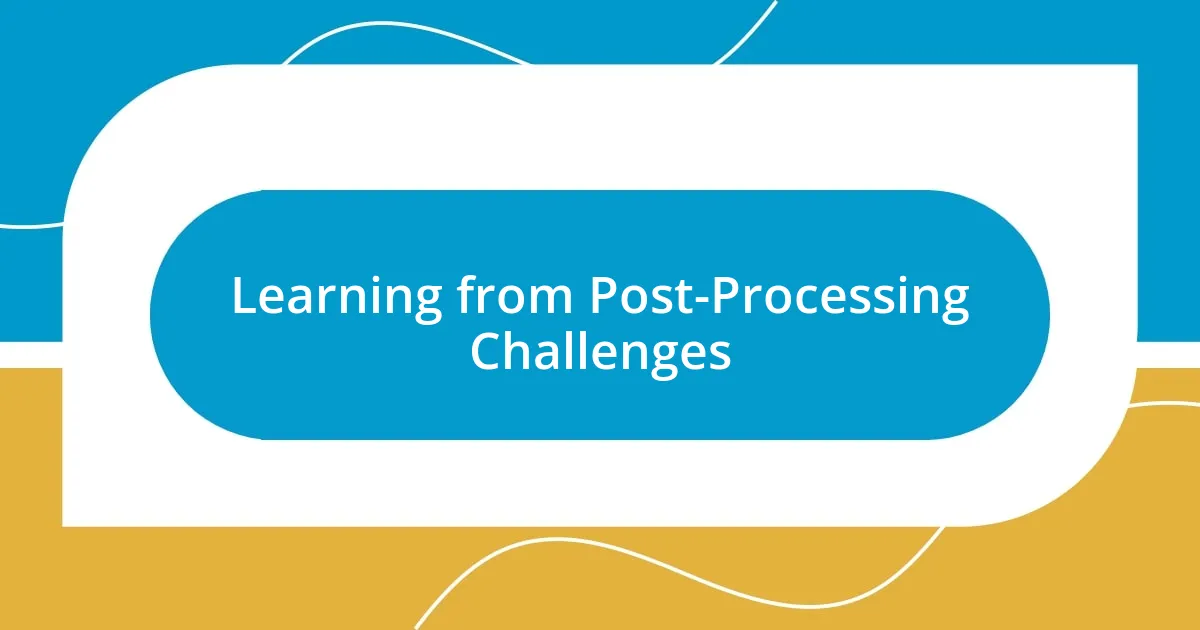Key takeaways:
- Slowing down and planning for optimal lighting can significantly enhance landscape photography.
- Foreground interest and compositional techniques, such as the rule of thirds, are essential for creating dynamic images.
- Proper camera settings and manual adjustments are crucial for achieving the desired photographic effects.
- Post-processing requires careful attention; one-at-a-time editing allows for greater emotional connection to the final image.

Understanding Landscape Photography Mistakes
Mistakes in landscape photography often stem from a rushed approach, which I know all too well. I remember the excitement of capturing the sunset over a mountain range, only to realize later that I had neglected to check my composition and settings. How could I miss something so crucial? It taught me that sometimes, slowing down can lead to far more rewarding shots.
One of the biggest lessons I learned was about the importance of lighting. On one occasion, I arrived at a breathtaking location, but the harsh midday sun washed out the colors. I felt frustrated, sitting there with my camera, wishing I had planned for the golden hour instead. Isn’t it amazing how the right light can transform a scene entirely?
Another common mistake is overlooking the foreground. I recall a time when I shot a beautiful landscape but found the image lacked depth and interest. The background was stunning, yet my composition fell flat. What I learned from that experience was to always consider how different elements in the frame can interact; foreground interest can elevate a photograph from ordinary to extraordinary.

Common Errors in Composition
When I first began exploring landscape photography, I often fell into the trap of centering my subject. It seemed like the natural thing to do; however, I soon realized that this can sometimes lead to a static and uninspiring composition. I vividly recall a snowy scene I shot, which, to my dismay, looked bland and unbalanced. I learned that using the rule of thirds or breaking it entirely can create a more dynamic visual appeal.
Here are some common errors in composition that I think many photographers, myself included, often encounter:
- Neglecting the rule of thirds: Placing the horizon line directly in the center can make the image feel flat.
- Not considering leading lines: Failing to use natural lines to guide the viewer’s eye can make a photograph less engaging.
- Ignoring the background: I often found myself captivated by the foreground, only to neglect the all-important background elements, which can either enhance or distract from the main subject.
- Forgetting scale: It can be easy to overlook including an element that gives context to the size of your subject, which can make a huge difference in the impact of the image.
- Overstuffing the frame: In my eagerness to capture everything, I sometimes crammed too many elements into the shot, diluting the focal point.
Reflecting on these mistakes has been invaluable in my growth as a landscape photographer, guiding me toward creating more compelling images.

Importance of Lighting in Photography
Lighting can truly make or break a photograph, and I learned this firsthand during a trip to a serene lake at dawn. As I set up my shot, the soft light of the rising sun created a gentle glow over the water. At that moment, I realized that the golden hour held a magic I had previously underestimated. It transformed the whole landscape, adding a warmth that would have been absent in harsh daylight. Have you ever experienced that euphoric feeling when everything just clicks into place?
In another instance, I aimed for a dramatic shot of a rugged mountain range under an overcast sky. Initially disappointed with the lack of direct sunlight, I soon discovered the beauty in the diffused, soft light that highlighted the textures of the rocks. This taught me that even on gloomy days, lighting has a unique role to play. The subtle tones and contrasts offered a mood that harsh sunlight couldn’t replicate. I learned to embrace the light every situation brings, rather than relying solely on bright, sunny days to produce quality images.
It’s curious how different times of the day evoke varied feelings and perspectives in photography. Each lighting condition tells a story. I remember capturing the same location at dusk, just as the colors in the sky began to change. The scene looked entirely different; it was moody yet inviting. By experimenting with light, I found that I could elicit different emotions from my audience, which ultimately makes photography such a compelling art form.
| Lighting Quality | Impact on Photography |
|---|---|
| Golden Hour | Soft, warm light enhances colors and adds depth |
| Midday Sun | Harsh light creates strong shadows and can wash out colors |
| Overcast Sky | Soft, diffused light brings out textures and muted tones |
| Dusk | Rich colors and dramatic contrasts evoke deeper emotions |

Techniques for Better Color Management
I love the vibrant hues of sunrise in my photographs, but I learned the hard way that shooting in auto white balance can throw those colors off. During one early morning shoot, I was thrilled to see the sky transform into a canvas of oranges and pinks. However, when I reviewed my images, they appeared washed out and dull. Now, I always set the white balance manually or shoot in RAW, allowing me the flexibility to adjust tones in post-processing while retaining that stunning color range.
Having a color calibration tool has truly changed everything for me. I vividly remember an afternoon spent editing a landscape where the greens looked too vibrant, and the blues were uncomfortably cool. I realized my monitor wasn’t calibrated. Once I invested in a calibration device, everything looked true to life! My prints matched the on-screen images, and that satisfaction was beyond compare. So, if you’re struggling with colors not translating from screen to print, consider giving calibration a try!
Lastly, the power of color theory can’t be overstated. I once found myself frustrated with a photo that just didn’t pop. Then, I revisited the basics and realized that the contrast between warm and cool colors could invigorate the scene. After adjusting the saturation and playing with complementary colors, that same image transformed into something mesmerizing. How often do we forget to use simple fundamentals? Color harmony can elevate your work significantly, making your landscapes not just seen but felt.

Adjusting Settings for Optimal Results
Adjusting camera settings is where the magic truly happens in landscape photography. I once set out to capture a stunning waterfall, excited to freeze the flow of water. However, I forgot to increase my shutter speed and ended up with a blurred mess instead of the silky-smooth effect I envisioned. It was frustrating, but that mistake taught me the importance of knowing how to balance my aperture and ISO with shutter speed to get the shot I wanted. Have you ever experienced a moment where you realized your settings were all wrong?
I vividly recall a day shooting expansive desert vistas. I noticed how quickly the light changed as clouds rolled in, tossing shadows across the terrain. In the past, I might have panicked and rushed my settings, but instead, I calmly adjusted my ISO, letting the camera breathe in the available light. This adjustment not only saved my images but added an unexpected depth to my photos. Little changes can lead to a dramatic shift in results, and it’s those adjustments that can turn a simple shot into something extraordinary.
Take the time to experiment with manual settings; it’s worth it. There was a moment on a foggy morning when I allowed myself to play with exposure compensation. I was astonished at how adjusting just one click brighter transformed the muted tones of the misty landscape into a dreamy scene that felt like stepping into a painting. It’s these personal revelations that build our understanding as photographers. So, next time you’re out, don’t hesitate to explore your settings; you might stumble upon a masterpiece waiting to be discovered right through your lens.

Learning from Post-Processing Challenges
I’ve found that post-processing can often feel overwhelming, especially when I’m faced with a clutter of files on my screen. There was a time when I edited multiple images at once, thinking I could save time. However, it resulted in a chaotic blend of styles that strayed too far from what I originally saw through the lens. Now, I process images one at a time, allowing me to pour my heart and vision into each edit. Have you ever felt lost amidst the layers of editing?
Lost in shadows and highlights, I’ve sometimes neglected the power of histograms. I can remember an evening when I thought my edits were spot on, only to be greeted by a dreaded surprise: blown-out highlights in my skies. That’s when I began to pay closer attention to my histogram. Utilizing this tool has since guided my adjustments, ensuring I maintain detail and depth. It’s surprisingly comforting to know that with just a glance, I can see where the balance lies.
Lastly, I can’t underestimate the importance of context when it comes to editing. I recall a scene from my travels where the vibrant sunset painted the landscape, but I over-processed the colors in excitement. The result? An unnatural look that haunted me. I learned to step back and ask myself: Does this edit communicate the essence I felt at that moment? This simple reflection helped me create imagery that resonates more deeply with both myself and my audience. It’s about capturing the emotions behind the lens and translating them into our edits. Do you take a moment to reconnect with the scene before you wrap up your processing?

Building Resilience through Continuous Practice
Building resilience in landscape photography is often a byproduct of continuous practice. I remember a particularly harsh winter day when I ventured out to capture icy landscapes. The biting cold forced me to adapt quickly—first, I nearly froze my fingers trying to adjust my camera settings! But each stumble taught me how to effectively layer my clothing and manage equipment well in challenging conditions. Have you ever faced a weather challenge that made you rethink your approach?
As I’ve honed my skills through shooting in diverse environments, I’ve also learned the importance of patience. One day, while shooting at sunrise, I arrived only to find a thick fog obscuring my view. Instead of packing up in frustration, I decided to embrace the unexpected and waited quietly. That fog ultimately revealed a soft, ethereal landscape that painted a serene scene I would have otherwise missed. Moments like this solidified for me that resilience grows when we learn to adapt rather than react, don’t you think?
The act of practicing consistently allowed me to develop a more profound connection with my surroundings. I distinctly recall a trip to photograph coastal cliffs. After several failed attempts, I realized that I wasn’t just capturing images—I was documenting my journey through each failure and triumph. Engaging with my environment regularly nurtured my ability to see beauty in the imperfect, teaching me to appreciate every mistake as merely a stepping stone. It’s through these persistent efforts that we transform our relationships with both our craft and ourselves. Have you found a similar growth in your own artistic endeavors?














